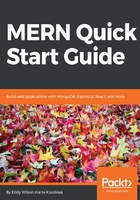
What this book covers
Chapter 1, Introduction to MERN Stack, provides an introduction to the MERN stack and the MVC architectural pattern. It covers installation of NodeJS and MongoDB as well as installing NPM packages and an example of usage. These constitute the base for all the book's recipes.
Chapter 2, Building a Web Server with ExpressJS, covers core concepts about the HTTP protocol, the “http” NodeJS module, and how it is all connected with ExpressJS. It explores all features of ExpressJS for building Web Server applications from route handlers and middleware to secure a Web Server application and debugging.
Chapter 3, Building a RESTful API, explains core concepts about what is REST, URLs, and CRUD operations. These concepts are the base for the whole chapter. It also explores how to make CRUD operations in ExpressJS and with Mongoose as well as where and how ExpressJS and Mongoose fit in the MVC architectural pattern. It covers the creation of Mongoose schemas and models as well as different types of Mongoose middleware and validation of data.
Chapter 4, Real-time Communication with Socket.IO and ExpressJS, gives a brief introduction to NodeJS events and how bi-directional communication with WebSockets works. It also goes through using SocketIO and ExpressJS to build Web Applications that deliver data in real time.
Chapter 5, Managing State with Redux, covers what Redux is and the three core principles. It also covers the very basic idea of Redux from how Array.prototype.reduce works, to how reducers are defined and how to write middleware functions as well as advanced concepts such as writing store enhancers, time traveling, and asynchronous data flow.
Chapter 6, Building Web Applications with React, explains what React is, what JSX syntax is, and where in the MVC architectural pattern it fits. It explores all core concepts of React in the form of easy-to-follow and build recipes. The recipes cover topics about composition, life cycle methods, controlled and uncontrolled components, error boundary components, and others such as type checking with PropTypes and Portals.